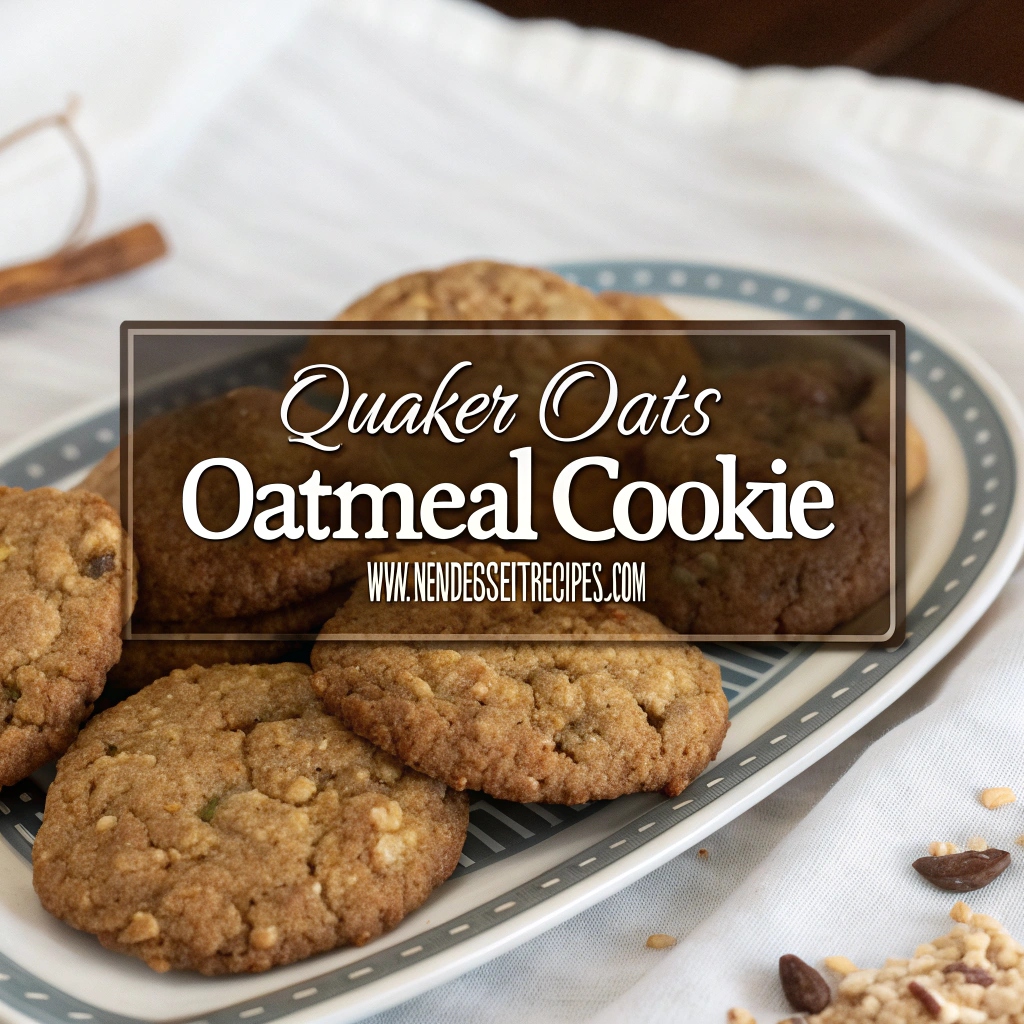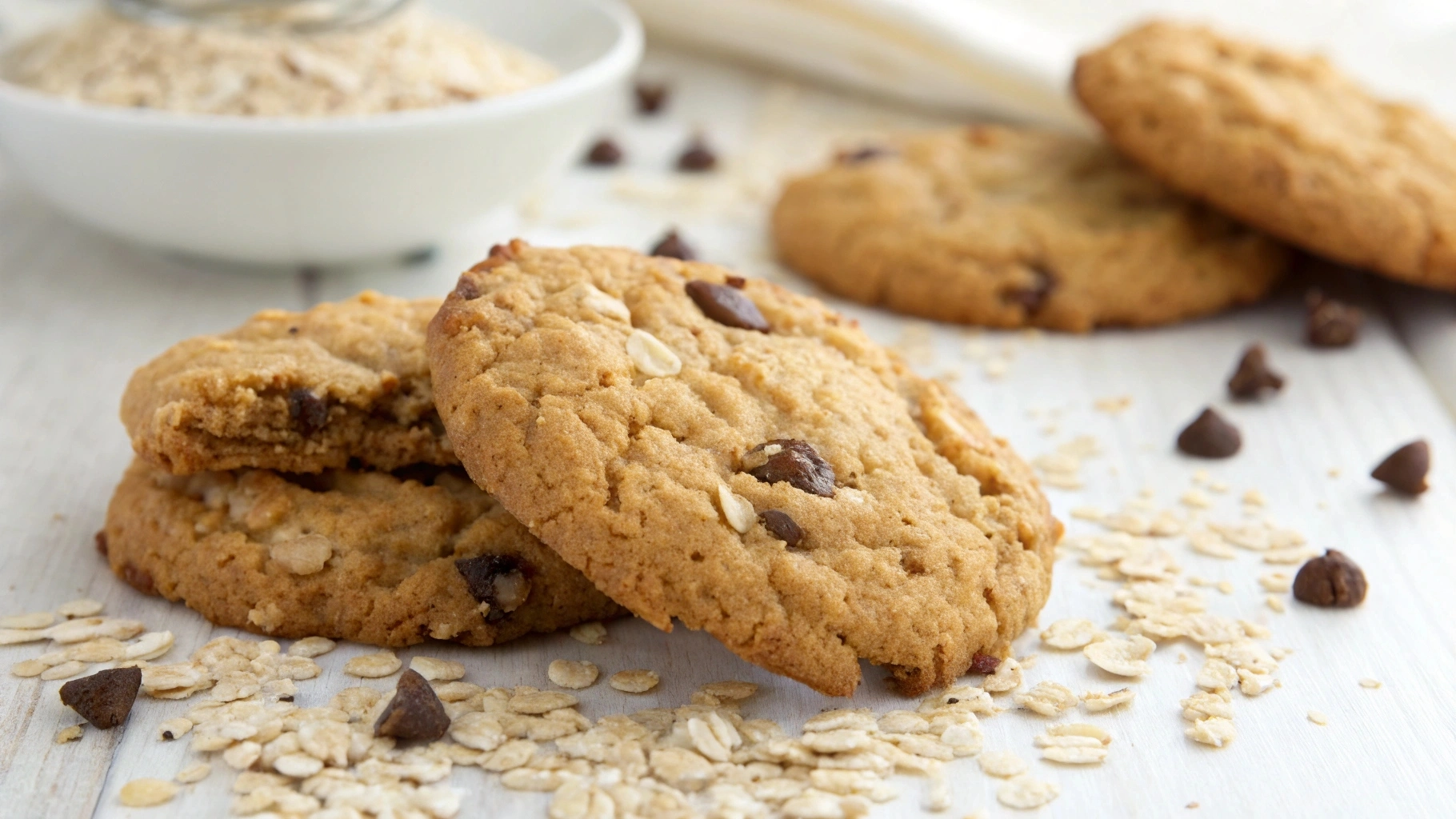Quaker Oats Oatmeal Cookie
Table of Contents
Quaker Oats Oatmeal Cookie
There’s something undeniably comforting about the aroma of freshly baked oatmeal cookies wafting through your home. That sweet, buttery scent tinged with cinnamon and vanilla instantly transports many of us back to childhood kitchens and moments of pure joy. Among the countless oatmeal cookie recipes that have graced family cookbooks over generations, the Quaker Oats version stands as perhaps the most iconic and beloved.
This isn’t just any cookie recipe – it’s a piece of American baking heritage that has remained largely unchanged since it first appeared on Quaker Oats packages decades ago. The beauty of this classic lies in its perfect balance: crisp edges giving way to chewy centers, hearty oats providing wonderful texture, and that ideal sweet-but-not-too-sweet flavor profile that keeps you reaching for “just one more.”
Whether you’re an experienced baker or trying your hand at homemade cookies for the first time, this famous recipe delivers consistent, delicious results that rarely disappoint. Let’s dive into everything you need to know to recreate these timeless treats in your own kitchen.
Shopping List for Quaker Oats Oatmeal Cookies
Dry Ingredients
- 1½ cups all-purpose flour
- 1 teaspoon baking soda
- 1 teaspoon ground cinnamon
- ½ teaspoon salt (table salt works best)
- 3 cups Quaker® Old Fashioned Oats
Wet Ingredients
- 1 cup (2 sticks) unsalted butter, softened
- 1 cup firmly packed brown sugar
- ½ cup granulated sugar
- 2 large eggs
- 1 teaspoon pure vanilla extract
Optional Ingredients
- 1 cup raisins or dried cranberries
- 1 cup semi-sweet chocolate chips
- 1 cup chopped nuts (walnuts or pecans work beautifully)
- ½ cup shredded coconut


How to Make Classic Quaker Oats Oatmeal Cookies
Creating these iconic cookies involves a straightforward process that even novice bakers can master with ease:
- Prepare your oven and equipment: Preheat your oven to 350°F. Line baking sheets with parchment paper or lightly grease them.
- Combine dry ingredients: In a medium bowl, whisk together the flour, baking soda, cinnamon, and salt. This ensures even distribution of the leavening agents and spices.
- Cream the butter and sugars: In a large bowl, beat the softened butter with both sugars until the mixture becomes light and fluffy, typically about 3-4 minutes with an electric mixer. Don’t rush this step – proper creaming incorporates air into the dough and contributes to the cookies’ ideal texture.
- Add eggs and vanilla: Beat in eggs one at a time, allowing each to incorporate fully before adding the next. Stir in the vanilla extract.
- Incorporate dry ingredients: Gradually add the flour mixture to the wet ingredients, mixing just until combined. Overmixing at this stage can lead to tough cookies.
- Fold in the oats and optional add-ins: Gently stir in the oats and any optional ingredients like raisins, chocolate chips, or nuts until evenly distributed.
- Scoop and bake: Drop rounded tablespoonfuls of dough onto prepared baking sheets, spacing them about 2 inches apart. Bake for 10-12 minutes or until golden brown around the edges but still slightly soft in the centers.
- Cool properly: Allow cookies to cool on the baking sheets for 2 minutes before transferring them to wire racks to cool completely.
Favorite Oatmeal Cookie Recipe
What makes this Quaker Oats recipe the favorite of so many bakers? The secret lies in its versatility and reliability. The base recipe creates perfectly balanced cookies with just the right amount of sweetness and warm cinnamon notes, but it also serves as an excellent canvas for customization.
Some bakers swear by the classic raisin version, while others are devoted chocolate chip fans. The truth is, this dough accommodates nearly any mix-in you can imagine, from butterscotch chips to dried cherries, from chopped candied ginger to toasted pecans.
The cookies maintain their quality for days when stored properly, developing deeper flavors as they age (though they rarely last that long in most households). They freeze beautifully both as dough and as baked cookies, making them perfect for advance preparation or preserving a batch for future cravings.
Fun Fact
Did you know that the Quaker Oats Company first introduced their oatmeal cookie recipe in the early 20th century? The recipe was originally printed on their iconic cylindrical packages as a way to encourage consumers to use their product beyond breakfast porridge. Little did they know they were creating what would become one of America’s most beloved cookie traditions!
Over the years, the recipe has been only slightly modified, primarily to adjust for changes in available ingredients and modern baking techniques. This remarkable consistency speaks to the recipe’s perfection – when something works this well, there’s little reason to change it.
Storage and Freezing Quaker Oatmeal Cookies
These cookies store exceptionally well, retaining their wonderful texture and flavor for several days. Here are the best methods for keeping them fresh:
Short-term storage: Place completely cooled cookies in an airtight container at room temperature with a slice of bread to maintain moisture. They’ll remain delicious for up to 5 days.
Freezing baked cookies: Once completely cooled, layer cookies between sheets of waxed paper in an airtight container or freezer bag. They’ll keep for up to 3 months frozen. Thaw at room temperature for about an hour before serving.
Freezing cookie dough: Shape the dough into balls and flash-freeze on a baking sheet until solid, then transfer to freezer bags. When ready to bake, place the frozen dough balls on prepared baking sheets and add 2-3 minutes to the standard baking time. This method allows you to enjoy fresh-baked cookies whenever the craving strikes!
Substitutions and Additions for Oatmeal Cookies
The classic recipe is wonderfully adaptable to dietary needs and flavor preferences:
Gluten-free option: Substitute the all-purpose flour with a 1:1 gluten-free baking blend and ensure you’re using certified gluten-free oats.
Vegan version: Replace butter with vegan butter sticks (not spread), use flax eggs (1 tablespoon ground flaxseed mixed with 3 tablespoons water per egg), and ensure your add-ins like chocolate chips are dairy-free.
Lower sugar: Reduce both sugars by up to ¼ cup total without significantly impacting texture, especially if using sweet add-ins like chocolate chips or dried fruits.
Flavor variations:
- Add 2 tablespoons of molasses for a deeper, more complex flavor
- Include ¼ teaspoon of nutmeg along with the cinnamon for warm spice notes
- Mix in the zest of one orange for a bright, citrusy twist
- Stir in 1 tablespoon of instant espresso powder for coffee-infused cookies
Cooking Using Oatmeal
The versatility of oats extends far beyond cookies and breakfast porridge. Here are some additional ways to incorporate heart-healthy oats into your cooking:
- Use as a binding agent in meatloaf or vegetarian burger patties
- Add to smoothies for extra fiber and creamy texture
- Create a crunchy topping for fruit crisps and cobblers
- Make homemade granola with oats, nuts, and honey
- Use as a substitute for breadcrumbs in recipes like meatballs or as coating for chicken tenders
Baking Tips
Room Temperature
Always start with butter and eggs at room temperature. Cold ingredients don’t incorporate properly, leading to uneven texture. Take butter out of the refrigerator about an hour before baking, and place eggs in a bowl of warm water for 5-10 minutes if you’ve forgotten to bring them to room temperature ahead of time.
Baking Sheets
For consistent results, use heavy-gauge, light-colored baking sheets. Dark pans absorb more heat and can cause cookie bottoms to brown too quickly or even burn. If you only have dark baking sheets, reduce the oven temperature by 25°F and watch the cookies carefully.
Cookie Scoop
Investing in a cookie scoop (essentially a small ice cream scoop) ensures uniform cookies that bake evenly. Consistent sizing means consistent baking times and perfectly textured cookies every time.
Wire Rack
Don’t skip the cooling step on a wire rack. This allows air to circulate around the entire cookie, preventing soggy bottoms that can result from trapped steam when cookies cool on solid surfaces.
Measuring Ingredients
For the most accurate results, measure dry ingredients by weight using a kitchen scale if possible. If measuring by volume, use the spoon-and-level method for flour: spoon flour into the measuring cup and level off with a straight edge rather than scooping directly from the container, which compacts the flour.
Old Fashioned Oats vs Quick Oats
While the classic recipe calls for Old Fashioned (rolled) oats, you can substitute Quick Oats in a pinch. The texture will be slightly different – less rustic and chewy – but the cookies will still be delicious. Avoid using instant oatmeal packets, as these contain additives and sweeteners that will throw off the recipe’s balance.
More Classic Cookies
If you’ve mastered the famous Quaker Oatmeal Cookie recipe and are looking to expand your cookie repertoire, consider trying these other beloved classics:
- Chocolate chip cookies with browned butter for nutty depth
- Snickerdoodles rolled in cinnamon-sugar
- Buttery shortbread cookies dipped in chocolate
- Peanut butter cookies with the signature fork-cross pattern
- Chewy molasses cookies perfect for fall and winter
Each of these timeless recipes offers unique flavors and textures while building on fundamental baking techniques you’ve practiced with your oatmeal cookies.
How was the recipes ?
There are no reviews yet. Be the first one to write one.

